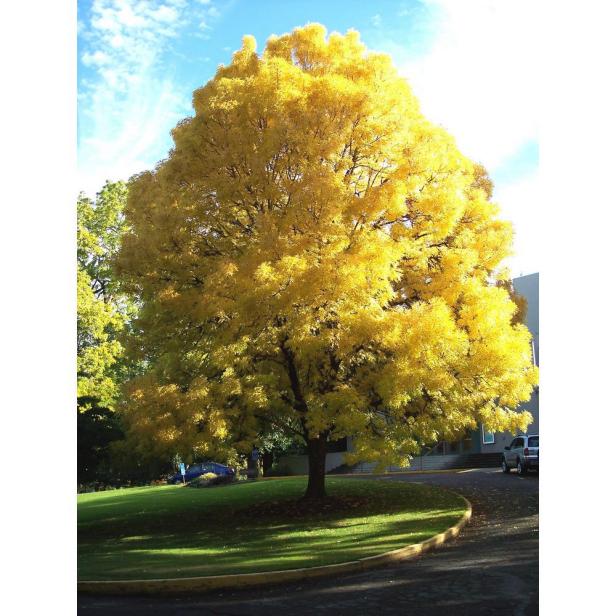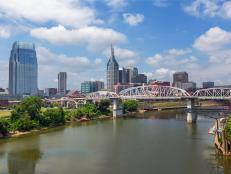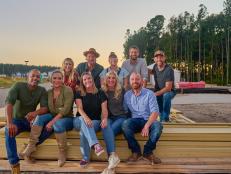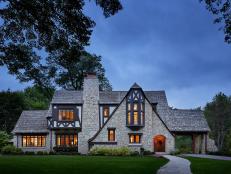Ash Tree Guide: How to Grow This American Beauty
One of the most common native tree species in America, the ash tree is beloved by landscapers and homeowners. Find out more about growing ash trees from HGTV garden experts.

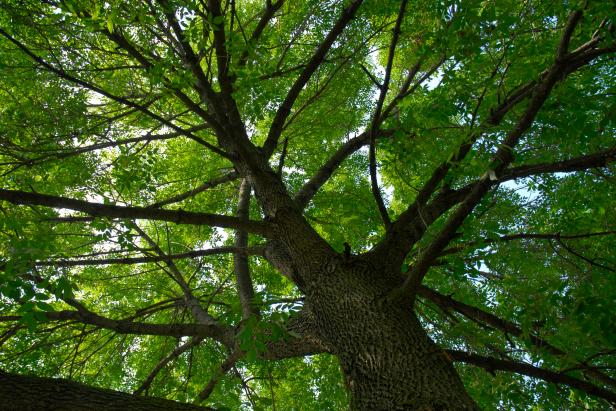
Chicago Botanic Garden
Fast-growing ash trees provide shade and adapt well to a variety of soils.
What Is an Ash Tree, Anyway?
Ash trees, native to the eastern United States, belong to the genus Fraxinus and the olive family. They're popular in landscapes, lawns and along streets, where they need little care and provide cool, leafy shade. Of the 45 to 60 species, the most common are white, black and green ash trees. They turn beautiful shades of yellow and burgundy in fall. Most are deciduous, but some hold their leaves. They're drought tolerant and hardy in USDA Zones 2 to 9.
Female ash trees are easy to identify by their clusters of winged fruits, called samaras. The fruits typically remain on the trees until late fall or early winter, when they can fall by the thousands. Female trees may or may not produce fruits in a given year, but males never produce fruits.
Ash trees have clusters of five to 11 leaflets with smooth or toothed margins. Once the trees mature, ridges with diamond shapes are visible on their bark. Younger trees have relatively smooth bark.
What Is a Mountain Ash?
Despite their name, mountain ash trees are not true ashes. They're genus Sorbus, in the rose family. American Mountain ash (S. Americana) is prized for its creamy, white blossoms, which appear as umbrella-like clusters in the tree's dense canopy each spring. By late summer, the flowers develop into hanging clusters of reddish-orange, berry-like fruits. In the fall, the dark green leaves, which have lighter undersides, turn brilliant yellow, orange and reddish-purple. Hardy in USDA Zones 2 to 5, these trees can reach 10' to 30' tall in full sun or light shade.
While mountain ashes are attractive in landscapes and lawns, you may want to avoid planting them near sidewalks, streets and walkways, where the fallen berries can be crushed underfoot. However, birds and other wildlife enjoy the berries, and the blossoms draw pollinators like bees and butterflies.
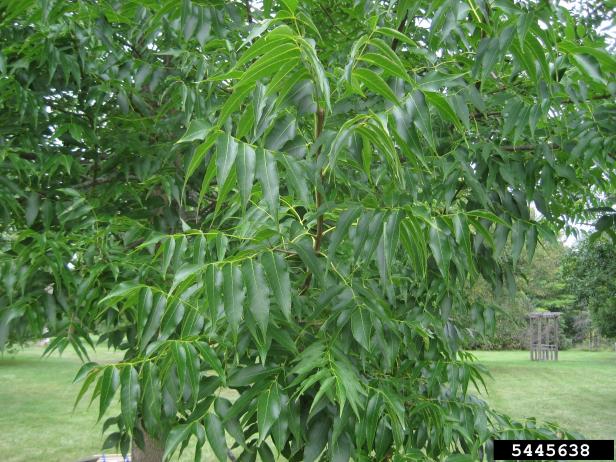
Rob Routledge, Sault College/Bugwood.Org
Ash trees like this blue ash have compound leaves arranged in opposite pairs, with five to seven leaflets on the central stem, called a rachis, of each leaf.
How to Plant an Ash Tree
Choose a site that gets full sun for your ash tree. Some average 40' to 60' in height, so don't plant too close to your home or other structures where their branches or roots might cause problems.
Ash trees grow best in soil where the pH measures between 4.0 and 7.0, so you may want to use a pH meter or test kit to see if your planting site needs amendments. If so, use the amounts recommended by your test results.
Dig a hole twice as wide as the tree's root ball and about one foot deeper than the height of the root ball. This will leave room to add good quality planting soil to the hole before you put in the tree and backfill with native soil.
Gently firm the soil around the tree's roots. Then carefully dig a small moat around the base of the tree, being careful not to damage the roots, and fill it with water. Ash trees need moist soil, especially when they're young and getting established. Water from a hose usually runs off before it can soak into the soil and reach the roots, so refill the moat when needed, or use a soaker hose around the tree, to help water penetrate deeply.
How to Prune an Ash Tree
Pruning is recommended since ash trees grow fast. Wait until the leaves drop in fall and the tree is dormant, but prune before ice or snow can fall and possibly damage the limbs.
Find the central leader branch and prune around it. First, remove any dead, dying or diseased branches from the base of the tree and work your way up. Use pruning shears on small branches and a pruning saw for larger ones. Cut each branch back to the node, or the first healthy joint, of the next branch. Avoid tearing the bark. To provide more sun and good air circulation, prune away any small branches that cross over other branches. Finally, remove branches that are very low and close to the ground.
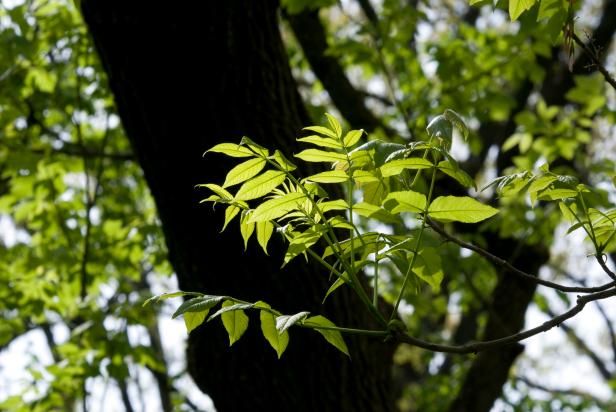
Chicago Botanic Garden
Black ash trees are long-lived, native trees that grow 30' to 50' high. Sadly, ash trees aren't recommended for planting in some areas because they often succumb to emerald ash borers.
Note: be safe and call a professional for help when pruning a tall tree.
How to Fertilize an Ash Tree
Fertilize your ash tree with a balanced tree fertilizer, following the directions on your product for when and how much to apply. Water thoroughly after fertilizing. Don't fertilize if your tree looks unhealthy or stressed, which can cause more harm than good.
Ash Tree Pests and Diseases
The emerald ash borer is the most destructive ash tree pest. It's a green beetle from Asia that has made its way into most U.S. states. Its larvae feed on the inner layer of bark, preventing water and nutrients from moving up the tree. In the spring, adult borers emerge, leaving D-shaped holes that bacteria and fungi can enter. It may take a few years, but infected trees, if left untreated, usually die from the top down.
Small trees have a better chance of survival. If the trunks are less than 2 feet in diameter, an insecticide soil drench can be applied in the spring to kill the borers. For larger trees, professionals must inject an insecticide through the trunk.
Verticillium wilt and ash anthracnose are fungal diseases that cause leaves to wilt and dieback. Entire trees may die. Verticillium wilt can't be cured but your tree may survive if you water and fertilize it properly and prune away dead or diseased branches.
Ash anthracnose can be recognized by brown and purple spots that form on leaves, which then drop prematurely. If caught early, this disease can be controlled by pruning away the infected branches and adding a low nitrogen, high phosphorus mix to the soil, which gives the tree more nutrients to help it return to health.
Some gardeners eliminate fungi by turning their soil to a depth of 6 inches and covering it with clear plastic. When sunlight hits the plastic, the soil temperatures rise enough to kill the fungi. Be careful not to injure your plant's roots if you turn your soil when trying this method. If your tree loses half or more of its leaves from either of these diseases, most experts recommend cutting it down.
Ash rust is not a severe disease, but it can recur and weaken ash trees. It causes yellow-orange spots on leaves. Consider applying a fungicide regularly to help prevent it.
Ash yellows is a serious disease that attacks white and green ash trees, causing leaves to turn pale green or yellow and drop. Entire branches may die. While there's no cure, you can treat infected trees in early stages by spraying with a fungicide. Also, fertilize the tree to make sure it has enough nutrients to fight the disease. Once more than one-third of the tree dies back, experts recommend cutting it down.
Aphids and scale are common ash tree pests. Both damage trees by sucking their juices and weakening or killing them. Curling or distorted leaves are signs of aphid damage, while dying stems and branches may indicate scale. Treat infested trees as soon as you see a problem, and ask your county extension service for advice on what to use. They may recommend using biological controls (such as microscopic wasps and other natural enemies of these pests) or chemical controls.
Common Types of Ash Trees
Black ash, Fraxinus nigra. This small-canopied tree grows 40' to 50' tall; its leaves turn yellow in fall. It's long-lived and hardy in USDA Zones 2 to 6. Birds feast on its berries, while deer and moose eat its foliage and branches.
This Pretty Garden Spotlights the Green Ash
A Sentimental Garden Tour 35 Photos
Plant flowers to give as gifts and that commemorate special people in your life. Find inspiration in this Atlanta garden full of colorful flowers made for gift-giving.
Green ash, Fraxinus pennsylvanica. This popular shade tree grows fast and is hardy in Zones 2 to 9. It matures at 50' to 60' tall and is also known as water ash, red ash or swamp ash.
White ash, Fraxinus Americana. Also called Biltmore ash, this tree is hardy in Zones 3 to 9 and tops out at 50' to 80' in height. The foliage becomes purplish-yellow in autumn.






